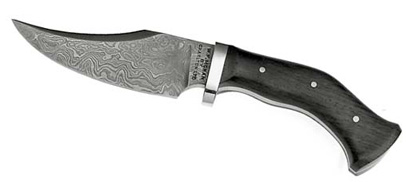
Word reached me earlier this afternoon that Bill Moran, the "Master of the Forge" and knifemaker extroardinaire who over thirty years ago re-discovered the long-lost secret of how to make Damascus steel, died last week at the age of 80.
This is so depressing a thing to report that it literally hurts doing so.
Hanging in my Dad's knife-shop is a photo of three men standing together, each smoking a pipe: Dad, legendary knifemaker George Herron, and Bill Moran. It's hung there for a few years now, like a good luck charm: may good fortune smile on Dad's forge as it has on these two gentlemen.
It was through Dad that I knew Bill Moran. When Dad asked me if I wanted to go down to Troy one Sunday to the community college where Moran was teaching a class on blade forging, I immediately said yes. I'll never forget the first time I met him, the way he smiled and had that twinkle in his eye. So help me, Moran had one of the friendliest smiles I've ever seen from anyone. Most of our family came to know him too. He always took time to talk to anyone who was interested in the fine art of knifemaking, and share whatever knowledge and wisdom - and his was considerable - that he happened to have.
So far as American legends go, God broke the mold with Bill Moran. I like to believe that he would have made his mark anyway with his prowess on the anvil. But what he'll forever be remembered for was when in 1973 he made the first Damascus steel blade to be produced in hundreds of years.

Damascus steel is multi-layered steel. You would recognize it immediately if you saw it, with its beautiful patterns and whorls of color. My Dad recently made a Damascus knife that, after the steel had been folded and re-folded, has four-hundred-and-five layers of steel compressed into one thin blade. It was a high artform in the Middle Ages, but over the centuries the secret of how to produce it had been lost. Moran found out how to do it again, and he shared his newfound knowledge with his fellow knifemakers. The result since then has been some of the most beautiful blades to ever be made... and Moran made the best of them.
 This was a guy who was good at his trade, and just had a plain good heart to him. And now he's gone. But I believe that Bill is in a far better place now, and has been happily reunited with the wife he loved so dearly. Part of me likes to believe that he's now turning his legendary intellect and skill toward making more knives, with the finest forge that Heaven can provide.
This was a guy who was good at his trade, and just had a plain good heart to him. And now he's gone. But I believe that Bill is in a far better place now, and has been happily reunited with the wife he loved so dearly. Part of me likes to believe that he's now turning his legendary intellect and skill toward making more knives, with the finest forge that Heaven can provide.
Well, I could go on, but that would just be adding to what a lot of other people have already said about Bill. There's some really good write-ups about him that I've found: The Washington Post and The Frederick News-Post have articles about him, and the News-Post also a special essay about Moran written by friend Pat Jamgochian that expresses who Moran was far better than anything I could do here. Moran was co-founder of the American Bladesmith Society, and it has set up a special memorial page for people's remembrances and photos of Bill. There's also a tribute to him at Never Yet Melted.
Sorry to see him go. The best words that come to my mind about Bill Moran are the same ones that Thomas Jefferson used to describe Benjamin Franklin: "No one can replace him."
EDIT 11:06 PM EST: Cutting Commentary has a collection of links to stories about Bill Moran and more photos of his handiwork.







1 comments:
Bill Moran did not re-discover the "lost" art of pattern welding (what you mistakenly call Damascus). Pattern welded steel has been in constant production in other parts of the world and the US for years. (See the pattern welded daggers made for the Nazi' in WWII, Philipino Kris, etc.) Manfred Sasche is a German knifemaker who has continued making pattern welded steel since WWII. All cultures that had/have steel working technology have made pattern welded steel.
Bill Moran popularized pattern welded steel in the US.
Post a Comment